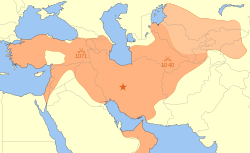সেলজুক সাম্রাজ্য: সংশোধিত সংস্করণের মধ্যে পার্থক্য
বিষয়বস্তু বিয়োগ হয়েছে বিষয়বস্তু যোগ হয়েছে
সেলজুক বংশ ট্যাগ: দৃশ্যমান সম্পাদনা মোবাইল সম্পাদনা মোবাইল ওয়েব সম্পাদনা |
আফতাবুজ্জামান (আলোচনা | অবদান) |
||
| ১ নং লাইন: | ১ নং লাইন: | ||
{{pp-protected|reason=Persistent [[WP:Disruptive editing|disruptive editing]]|expiry=18 December 2015|small=yes}} |
{{pp-protected|reason=Persistent [[WP:Disruptive editing|disruptive editing]]|expiry=18 December 2015|small=yes}} |
||
{{For|the ruling dynasty of the empire|Seljuq dynasty}}{{Infobox former country |
|||
{{For|the ruling dynasty of the empire|Seljuq dynasty}}একাদশ খ্রিস্টাদ্বের শেষার্ধর প্রথম দিকে (১০৫৫ খ্রি.)তুর্কি জাতিসত্তার অন্যতম গোত্র সেলজুক কর্তৃক বাগদাদ বিজয় ইসলামের ইতিহাসে একটি তাৎপর্যপূর্ণ ঘটনা।প্রফেসর হিট্টির মতানুসারে তাদের অভু্্যদয় ইসলাম ও আব্বাসি খেলাফতের ইতিহাসে এক নয়া ও উল্লেখ্য যোগ্য যুগের সূচনা করে।তার ভাষায়: The advent of seljuq turks ushers in a new and notable era in the history islam and caliphate পুনশ্চ তাদের অভু্্যদয় প্রাক্কালে ইসলামি বিশ্ব কিরুপ বহুকেন্দ্রিক বা শতধা বিচ্ছিন্ন হয়ে পরে তিনি তার বাস্তব অবস্থার একটি সংক্ষিপ্ত বিবরন ও দিয়েছেন।তিনি বলেন: If their appearence from the east in the early part of the eleventh century the caliph held out a shadow of her power and his empire had been almost dismembered.The umayyads in spain and shiite fatimids in Egypt and north africa were established beyond any hope of displacement from baghdad. North syria and uppor Mesopotamia... were in the hands off turbulent arab chieftain, some of whom had susucceeded in founding dynasties persis transoxiana and the lands to the east and south were perceled among buwayhid and ghaznavids power or had by sundray petty dynasties, each waiting for an opportunity to fly at the throat of the other,political and military anancly prevailed every were.shitte suny confusion was the order of the day.Islam seems crushed to the ground. {{Infobox former country |
|||
| conventional_long_name = Seljuk Empire |
| conventional_long_name = Seljuk Empire |
||
| common_name = Seljuk Empire |
| common_name = Seljuk Empire |
||
১৫:২৫, ২১ অক্টোবর ২০১৬ তারিখে সংশোধিত সংস্করণ
Seljuk Empire | |
|---|---|
| 1037–1194 | |
Imperial Symbol
| |
 Great Seljuq Empire in its zenith in 1092, upon the death of Malik Shah I | |
| অবস্থা | Empire |
| রাজধানী | Nishapur (1037–1043) Rey (1043–1051) Isfahan (1051–1118) Hamadan, Western capital (1118–1194) Merv, Eastern capital (1118–1153) |
| প্রচলিত ভাষা | |
| সরকার | Monarchy |
| Sultan | |
• 1037–1063 | Toghrul I (first) |
• 1174–1194 | Toghrul III (last)[৫][৬] |
| ইতিহাস | |
• Tughril formed the state system | 1037 |
• Replaced by the Khwarezmian Empire[৭] | 1194 |
| আয়তন | |
| 1080 est. | ৩৯,০০,০০০ বর্গকিলোমিটার (১৫,০০,০০০ বর্গমাইল) |
| বর্তমানে যার অংশ | |
| প্রাক ১৪শ শতাব্দীর তুর্কীয় জাতিসমূহের ইতিহাস |
|---|
 |
| তুরস্কের ইতিহাস |
|---|
| ধারাবাহিকের একটি অংশ |
 |
|
|
 |
| বৃহত্তর ইরানের ইতিহাস |
|---|
সেলজুক (অথবা সেল্ডজুক কখনো সেলজুক তুর্ক; তুর্কী ভাষায়: Selçuklular; ফার্সি ভাষায়: سلجوقيان সেলজুকাইন; আরবি ভাষায়: سلجوق সালজুক বা السلاجقة আল-সালাজিকা) সুন্নী মুসমান সাম্রাজ্য যারা ১১ শতক থেকে ১৪ শতক পর্যন্ত মধ্য এশিয়া এবং মধ্য প্রাচ্য শাসন করেছেন।
তথ্যসূত্র
- ↑ ক খ Savory, R. M., সম্পাদক (১৯৭৬)। Introduction to Islamic Civilisation। Cambridge University Press। পৃষ্ঠা 82। আইএসবিএন 0-521-20777-0।
- ↑ Black, Edwin (২০০৪)। Banking on Baghdad: Inside Iraq's 7,000-year History of War, Profit and Conflict। John Wiley and Sons। পৃষ্ঠা 38। আইএসবিএন 0-471-67186-X।
- ↑ ক খ গ C.E. Bosworth, "Turkish Expansion towards the west" in UNESCO History of Humanity, Volume IV, titled "From the Seventh to the Sixteenth Century", UNESCO Publishing / Routledge, p. 391: "While the Arabic language retained its primacy in such spheres as law, theology and science, the culture of the Seljuk court and secular literature within the sultanate became largely Persianized; this is seen in the early adoption of Persian epic names by the Seljuk rulers (Qubād, Kay Khusraw and so on) and in the use of Persian as a literary language (Turkish must have been essentially a vehicle for everyday speech at this time)."
- ↑ Concise Encyclopedia of Languages of the World, Ed. Keith Brown, Sarah Ogilvie, (Elsevier Ltd., 2009), 1110; "Oghuz Turkic is first represented by Old Anatolian Turkish which was a subordinate written medium until the end of the Seljuk rule."
- ↑ A New General Biographical Dictionary, Vol.2, Ed. Hugh James Rose, (London, 1853), 214.
- ↑ Grousset, Rene, The Empire of the Steppes, (New Brunswick: Rutgers University Press, 1988), 167.
- ↑ Grousset, Rene (১৯৮৮)। The Empire of the Steppes। New Brunswick: Rutgers University Press। পৃষ্ঠা 159, 161। আইএসবিএন 0-8135-0627-1।
In 1194, Togrul III would succumb to the onslaught of the Khwarizmian Turks, who were destined at last to succeed the Seljuks to the empire of the Middle East.
| এই নিবন্ধটি অসম্পূর্ণ। আপনি চাইলে এটিকে সম্প্রসারিত করে উইকিপিডিয়াকে সাহায্য করতে পারেন। |
